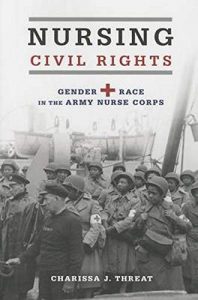|
Olivia Gordon (BA), History of Nursing Master’s student at the University of Huddersfield |
The UKAHN Bulletin |
| Volume 9 (1) 2021 | |

Charissa Threat’s book Nursing Civil Rights: Gender & Race in the Army Nurse Corps examines issues of race, gender and discrimination using the often-overlooked history of nursing. Taking the US Army Nursing Corps (ANC) as a case study, she investigates the experiences of African American female nurses and white male nurses during the twentieth century, as they fought for their pursuit for equal opportunities. Threat writes this piece of nursing history beautifully through the eyes of a civil rights movement, pushed for by both African American nurses and male nurses, as the nursing profession continued to struggle to support all nurses and failed to be inclusive.
Since the American Civil War, when nursing as paid employment first became respectable, African American women who wanted to nurse were restricted to nursing their own, not allowed to integrate with the rest of society, never mind care for sick white people. However, as happened in many other sections of society, war disrupted the status quo and as shortages of nurses became increasingly worse pressure to admit African American nurses grew. Threat focusses, particularly in Chapter 2, on the effect of World War 2 on recruitment policies into the Army Nursing Corps, demonstrating how military service was seen to provide African Americans with their way to make a change in the nursing profession and to try and dismantle the racial stereotypes that many, within the profession, still held. In fact, until 1944, all branches of the military refused to admit African American nurses into their cadres and it was only when acute nurse shortages hit a critical level that the Army Nurse leaders were pressured to open up the ANC to African American women. Even then, Black nurses were on the whole assigned only to military hospitals caring for Black soldiers. Threat highlights the struggles and setbacks that African American nurses faced and emphasized that although new opportunities became available during the World Wars, it did not change the traditional values and beliefs retained by most of society. This left many African Americans to lose their posts in the aftermath of war. Threat ultimately argues that although African American nurses fought to be allowed into the profession and gained their deserved nurses titles, there remained no rule for equal treatment, and therefore their battle for equality continued.
Threat goes on to investigate the second strand of discrimination she identified, the rejection of male nurses by the ANC. The history of male nursing in general is a very under-researched topic so Threat’s work in this book is a welcome contribution to the subject. She also attempted to merge both her themes, by looking for histories of Black male nurses in the military, but was stymied to a great extent by a lack of prior historical research and evidence. However, she has shone a light on the experiences of male white nurses, providing an in-depth history of their struggles throughout the twentieth century, and particularly in the military, before their eventual acceptance in 1955. Threat highlights how gender stereotyping caused men to be discouraged, or even prevented, from becoming nurses; they were seen as incapable of providing the same care that a woman could; were not allowed to provide care for women or children; and were seen as less adaptable and competent than female nurses. General societal prejudices were reflected within the military, where the ANC was run by a (white) female-dominated hierarchy who felt threatened by potential male recruits. Threat makes the interesting argument that through concentration on their own fights for equality, women overlooked or even ignored how they had enabled sex discrimination within the nursing profession, both at large and within the military. Nursing was one of the few professions where women had power over men, providing women with job security and a niche to call their own. Threat argues that there was only one way to remove the clearly defined gender constructs of nursing, and that was the importance of men being accepted into the profession.
Threat’s overarching argument is that issues of race and gender often mattered more than who was doing the job or not. With a fantastic array of primary and secondary literature, Threat is able to show the progression of the nursing profession as it progressed from a predominantly white female profession at the start of the century to a more inclusive profession by the mid twentieth century, albeit that it still had a long way to go. Threat ultimately argued that as we discover the history of the professionalization of nurses, we also see nurses argue between themselves over what it truly means to be a professional nurse.
